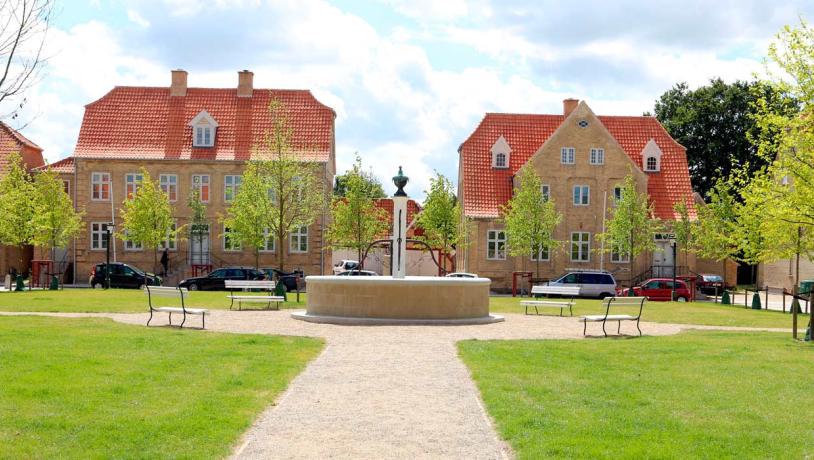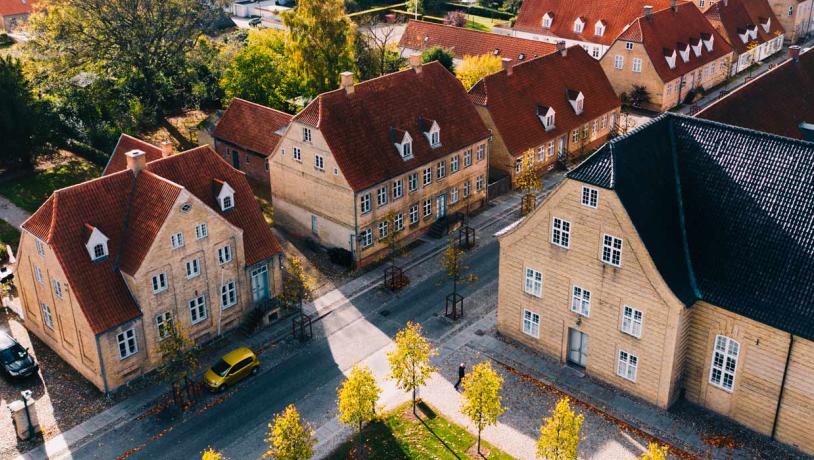
An Outline for the Herrnhuters
Explore the planned city of Christiansfeld. It is one of Denmark's first cities that resulted from actual urban planning.
The Brethren’s City Plan
The Brethren's city plan was created with clarity and rigor. Today, Christiansfeld has been designated as a UNESCO World Heritage Site. The project was initially a success, but the economic and social boost faded away when Denmark had to cede Schleswig.
It Started with the City of Herrnhut in Germany
In 1722, a religiously persecuted brotherhood sought asylum with Ludwig von Zinzendorf, a landowner in Saxony. Here, the Brethren established the city of Herrnhut and founded the "Renewed Moravian Unity," thereby creating the Herrnhut Brethren.
The congregation saw itself as missionary and established brethren congregations in other countries, such as America, England, Holland, and Sweden. They were known as diligent and skilled craftsmen. In 1771, they were invited to establish a brethren town in Denmark to promote economic growth and trade, primarily in Schleswig and Holstein. The congregation accepted the offer, which also provided ten years of tax exemption and subsidies for construction costs.
 © VisitKolding. Photo: VisitKolding.
© VisitKolding. Photo: VisitKolding.
From Open Field to World Heritage
The Brethren had good experience in city building by 1771. Christiansfeld is thus the twenty-fifth city constructed by the congregation. It is also the city that is closest to the ideal the Brethren strived to realize. The many technical, architectural, and urban planning experiences culminated in Christiansfeld.
The plan is simple and rigorous. The church and churchyard occupy the central space in the city plan. From here, the entire city layout is laid out and measured. The two main streets run parallel in an east-west direction past the church, framing the churchyard. Surrounding the square are the city’s most important buildings: the Church/HallHouse, the Sister House, the Widow's House, as well as the homes of the pastor and the steward. The Sister House and the Widow's House are so-called choir houses, which also include the Brother House. The congregation was divided according to gender; thus, unmarried women lived in one communal house and unmarried men in another.
The gender division was also enforced during church services. Even in God's Acre—the Brethren's cemetery—brothers are buried to the west and sisters to the east. However, there is no difference between the individual graves. The stones are uniform in expression—just as people are equal—it also applies in death.
 © Museum Kolding. Photo: Museum Kolding.
© Museum Kolding. Photo: Museum Kolding.
The Cheerful Pietists
Christiansfeld is a clean, bright, and rigorous city with aesthetic surplus. The buildings are made of light stone. Light floods into the city’s squares. Trees and gardens celebrate the green city long before it became fashionable. From the city, there is a view of nature. The good craftsmanship is visible to the naked eye.
The Brethren brought a bright and optimistic interpretation of Christianity to Denmark. In the Christian ideal city, there is room for everyone in a community supported by social considerations and individual development in a continuous striving for a life in God’s light. The Brethren have also been called the cheerful Pietists.
How Did the Plans Fare?
Yes, the king's plan to bring growth and prosperity to Southern Jutland went well for a few years. However, it suffered a setback with the lost war in 1864 and, not least, when industrialization took off in the latter half of the 1800s. Here, quantity triumphed over quality. On the other hand, the Brethren's plan to enter Denmark succeeded. In Christiansfeld, there is still a vibrant congregation with about 150 members. This is one of the reasons Christiansfeld was added to UNESCO's World Heritage List.